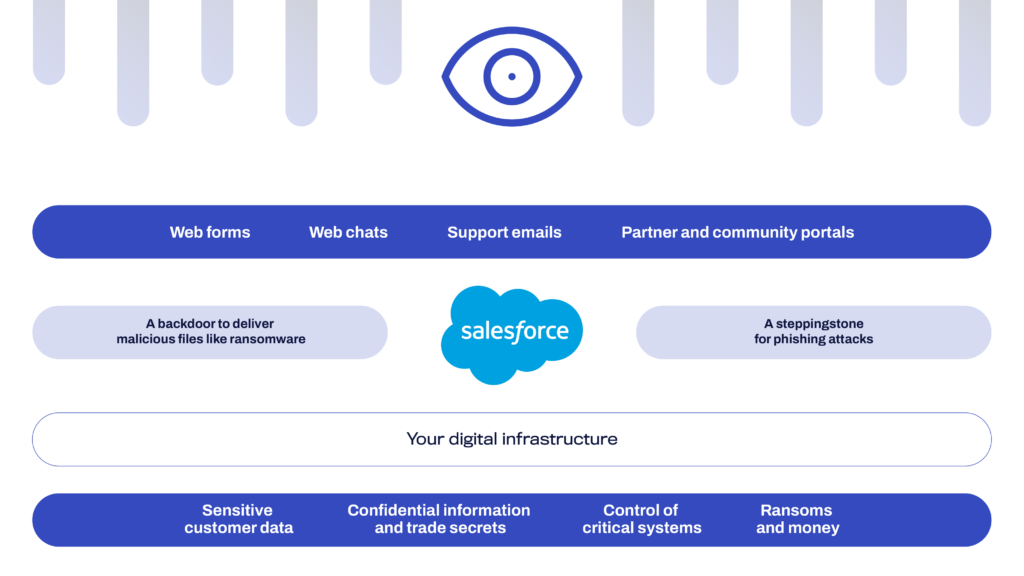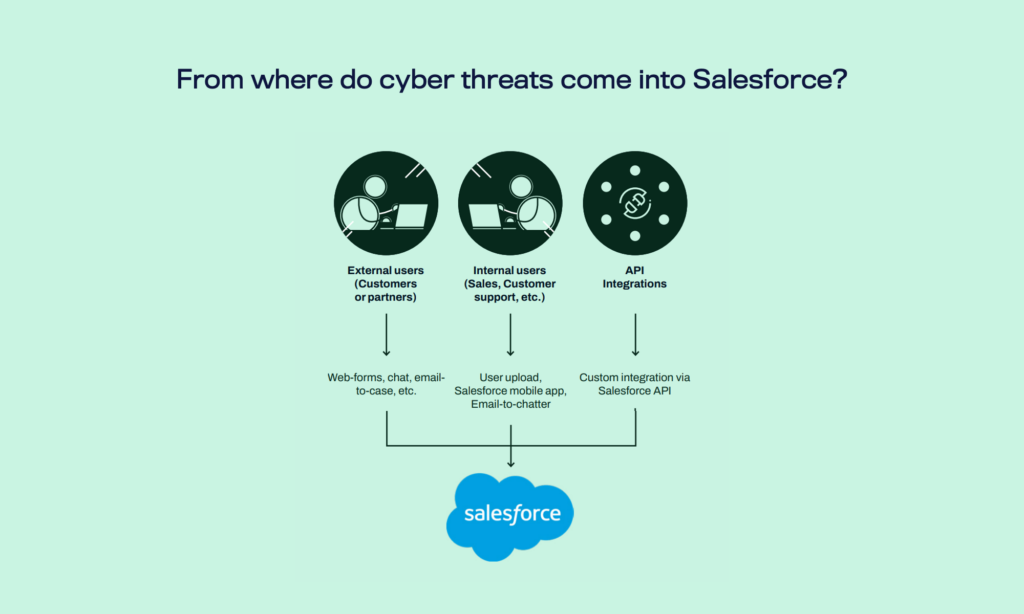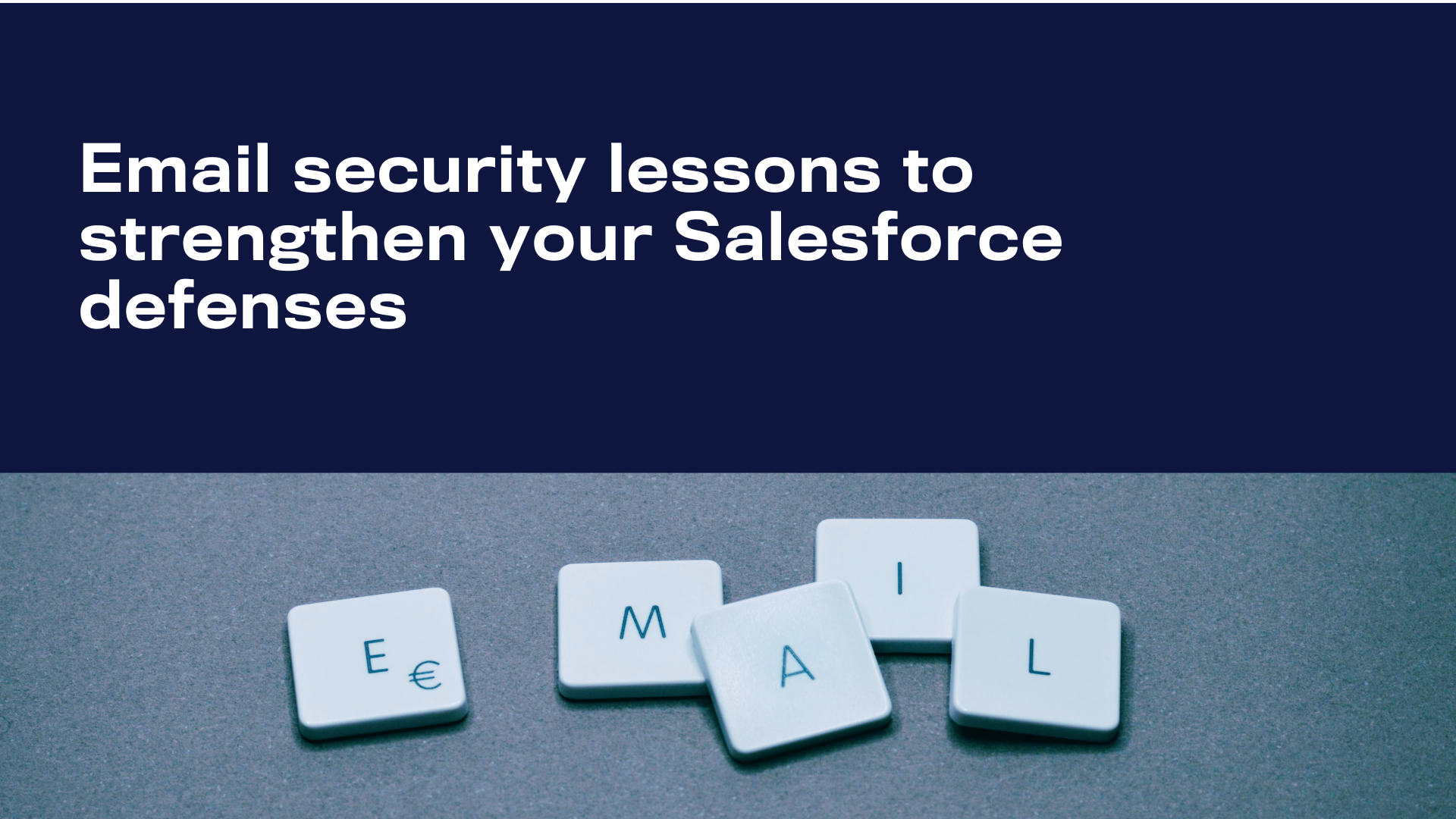Phishing is not confined to email but is a pervasive threat across our digital infrastructure. Salesforce, with its extensive cloud applications and public-facing nature, is emerging as a prime target for such cyber threats. Comprehensive phishing defenses should include Salesforce as an attack vector.
Phishing attacks have evolved but so have email defenses
While 41% of cyber attacks use phishing tactics, an alarming 26% of these attacks now exploit public-facing applications (like Salesforce), according to IBM’s report. Furthermore, 16% of phishing attacks misuse valid accounts.
Email, the traditional stronghold against phishing, has long been hardened through anti-malware and anti-phishing tools combined with consistent user education, with many providers offering built-in defenses and organizations adopting phishing simulation training. These measures have significantly heightened user vigilance and reduced the click rates on malicious emails.
How Salesforce becomes the entryway for cyber criminals
Salesforce serves as a central hub for diverse interactions across Sales, Service, and Experience Clouds, presenting multiple avenues for cyber threats. Each user interaction, whether from internal or external sources, could potentially introduce malicious content. Salesforce is vulnerable to the same types of attacks that have plagued email for decades.

Internal users frequently engage in routine activities like uploading documents and sharing URLs. For example, a sales representative might attach a contract embedded with malware in Sales Cloud, or a support agent may inadvertently attach a compromised troubleshooting guide in Service Cloud. Similarly, community managers in Experience Cloud might share links that lead to malicious sites.
The risk also involves unauthenticated users such as customers or potential leads who upload attachments in support cases or via Web-to-Lead forms. These necessary business interactions, if unchecked, provide easy entry points for cybercriminals.
Furthermore, authenticated users on Experience Cloud portals often share significant project files or access collaborative spaces, unintentionally spreading malware. The integration of APIs, which connects Salesforce with external systems like ERP software or tools like Slack, adds another layer of vulnerability. Each data transfer across these connections is a potential breach point.

Salesforce security falls short of email security standards
However, the security measures guarding Salesforce have not evolved at the same pace. There are no built-in anti-virus, anti-phishing, or basic spam filters that are standard in email services. This oversight leaves an obvious hole in cybersecurity strategies.
“Salesforce, often overlooked as an attack vector, presents a significant vulnerability in too many cyber security strategies,” notes Anssi Korpilaakso, Director of Sales and Business Operations at WithSecure™. “Our product backend has registered a steady increase in malware and phishing detections on Salesforce in the recent years.”

Salesforce users typically perceive Salesforce as a trusted tool, and are less likely to anticipate or recognize a phishing attack on the platform compared to email. This sense of trust is exactly what attackers who use psychological phishing schemes exploit.
Email: lessons for multi-layered Salesforce security
As cyber criminals continue to refine their strategies and target systems beyond traditional attack vectors like email, organizations must protect every entry point, including Salesforce. Learning from the widely adopted email security measures and applying these lessons to Salesforce helps fortify your digital infrastructure against dynamic cyber threats.
To tackle phishing effectively, you must adopt a multi-layered defense strategy that goes beyond email and encompasses Salesforce, your business critical platform. Here’s how you can start:
User training: Just as with email, the first line of defense is user awareness. Training users to recognize phishing attempts in Salesforce is crucial, as the platform’s familiar and trusted environment may lower their guard against suspicious activities. Although user education is important, you should not expect your Salesforce users to act as phishing detectives.
Integrate real-time threat protection: Given the lack of built-in anti-phishing and anti-malware features in Salesforce, integrating advanced security solutions that can provide real-time threat protection is essential. Solutions like WithSecure™ Cloud Protection for Salesforce offer tailored security measures that fit seamlessly into Salesforce, enhancing security without disrupting user experience.
What to consider when choosing the solution
When selecting a threat protection solution for Salesforce, you should prioritize efficiency, comprehensive coverage, and advanced detection capabilities that match today’s sophisticated cyber threats. Considerations for calculated decision-making:
- Prioritize solutions that add minimal complexity and avoid vulnerable integrations, focusing on native, straightforward security layers.
- Choose solutions that protect not only internal users but also mitigate the risk of malware spreading to customers and partners interacting with Salesforce by scanning uploads and downloads across various user types.
- Consider the evolving nature of threats, such as documents that contain latent phishing links, which may turn malicious after being uploaded to Salesforce, and after the initial scan at the point of upload. Opt for solutions that provide real-time protection, scanning content like files and URLs during all user interactions, not just at the point of upload.
- Ensure the solution offers real-time scanning and advanced behavioral analysis to detect embedded malware in seemingly benign documents, moving beyond traditional signature-based methods.
- Select solutions that encompass all Salesforce entry points, including custom objects in addition to standard objects, to ensure comprehensive coverage.
- Look for deep detection capabilities that can scan for malicious phishing links not only in text and emails but also within files, detect phishing links hidden behind QR codes, and identify zero-day malware in files as well as known threats.
WithSecure™ Cloud Protection for Salesforce eliminates risk of human error in real-time
Robust security measures equivalent to enterprise-grade email security help you experience the full potential of Salesforce without hidden risks. WithSecure™ delivers an advanced antivirus and antiphishing solution tailored uniquely for Salesforce. Developed in collaboration with Salesforce, WithSecure™ Cloud Protection for Salesforce meets the stringent requirements of highly regulated industries and government entities. You get real-time defenses against malware, ransomware, viruses, and phishing attacks, along with full security visibility for threat hunting and incident response. Multi-layer scanning ensures that every entry and touchpoint – from the Sales Cloud negotiations to Service Cloud interactions and Experience Cloud engagements – is covered.
Native integration ensures rapid deployment and comprehensive security without disrupting your existing Salesforce workflows.
Don’t let human error become your vulnerability in Salesforce security – especially when there are straightforward technologies to mitigate the risk. Whenever you are ready to take the next step, our team is ready to guide you in your Salesforce security.

